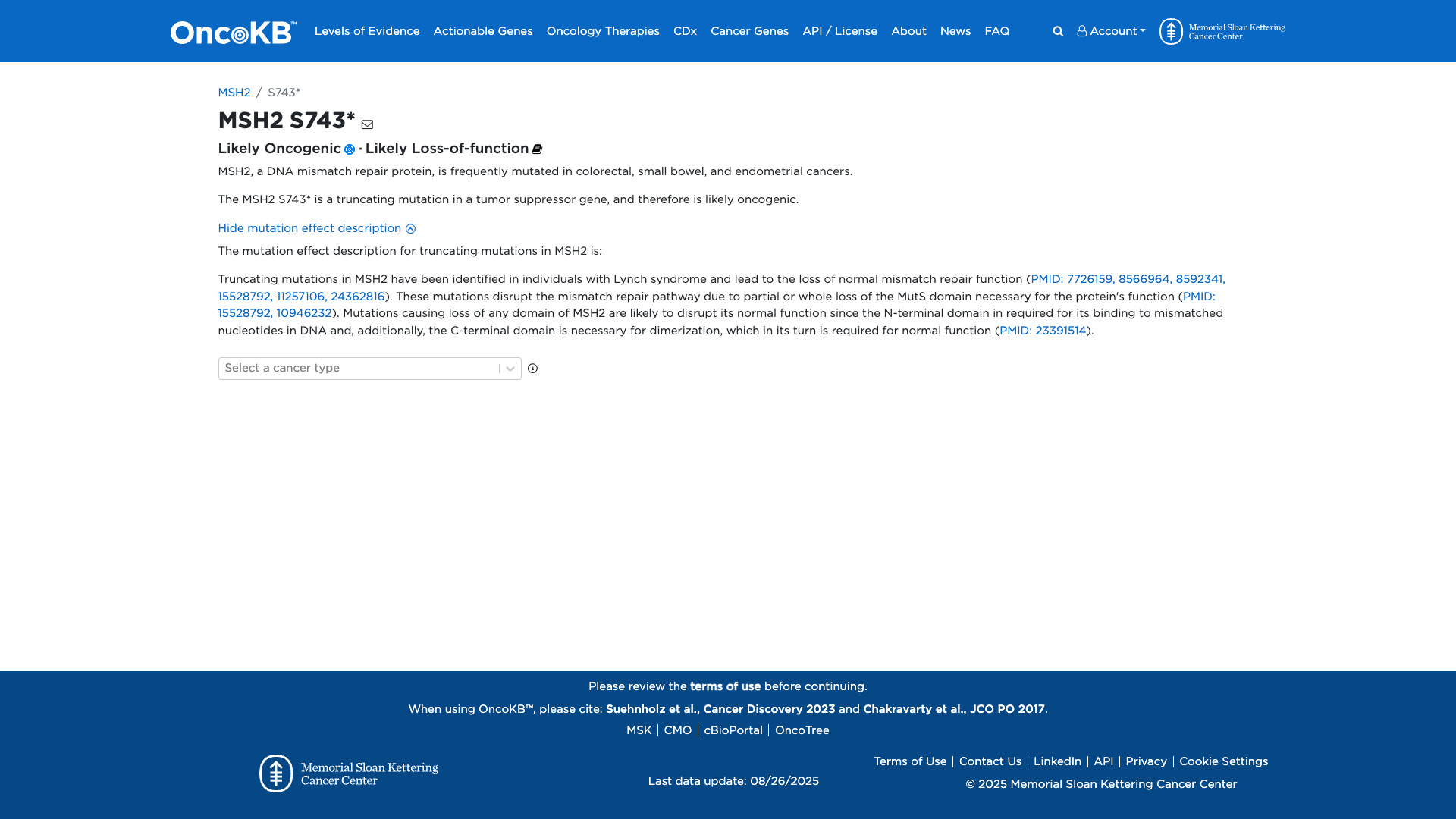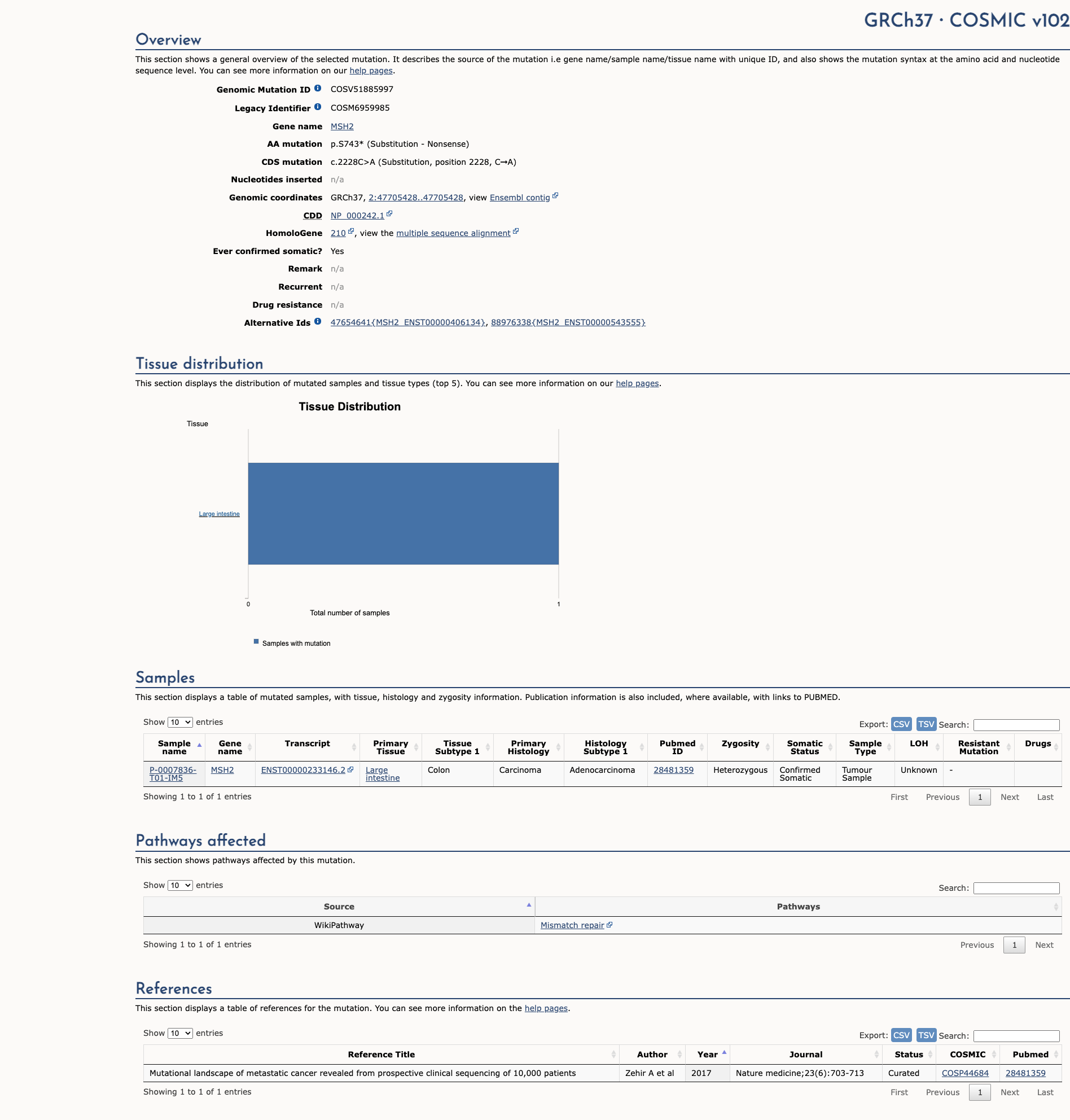MSH2 c.2228C>A, p.Ser743Ter
NM_000251.2:c.2228C>A
COSMIC ID: COSM6959985
Pathogenic
This truncating MSH2 variant introduces a premature stop codon at position 743 (≤891), meeting VCEP PVS1 Very Strong. Functional evidence supports an MMR defect (PS3 Moderate), it is absent from controls (PM2 Supporting), and reputable sources report it as pathogenic (PP5 Supporting). Together, these criteria support a Pathogenic classification.
ACMG/AMP Criteria Applied
PVS1
PS3
PM2
PP5
Genetic Information
Gene & Transcript Details
Gene
MSH2
Transcript
NM_000251.3
MANE Select
Total Exons
16
Strand
Forward (+)
Reference Sequence
NC_000002.11
Alternative Transcripts
| ID | Status | Details |
|---|---|---|
| NM_000251.2 | RefSeq Select | 16 exons | Forward |
| NM_000251.1 | Alternative | 16 exons | Forward |
Variant Details
HGVS Notation
NM_000251.2:c.2228C>A
Protein Change
S743*
Location
Exon 14
(Exon 14 of 16)
5'Exon Structure (16 total)3'
Functional Consequence
Loss of Function
Related Variants
Alternate Identifiers
COSM6959985
Variant interpretation based on transcript NM_000251.3
Genome Browser
Loading genome browser...
HGVS InputNM_000251:c.2228C>A
Active Tracks
ConservationRefSeqClinVargnomAD
Navigation tips: Use mouse to drag and zoom. Click on features for details.
Clinical Data
Population Frequency
Global Frequency
0.0 in 100,000
Extremely Rare
Global: 0.0%
0%
0.05%
0.1%
1%
5%
10%+
ACMG Criteria Applied
PM2
This variant is not present in gnomAD (PM2 criteria applies).
Classification
1 publications
Pathogenic
Based on 5 submitter reviews in ClinVar
Submitter Breakdown
4 Path
1 VUS
Pathogenic
Likely Path.
VUS
Likely Benign
Benign
Publications (1)
For these reasons, this variant has been classified as Pathogenic. Loss-of-function variants in MSH2 are known to be pathogenic (PMID: 15849733, 24362816). This variant has been observed in several individuals affected with Lynch syndrome (PMID: 14514376, 19324997, 21642682). ClinVar contains an entry for this variant (Variation ID: 90932). This variant is not present in population databases (ExAC no frequency). This sequence change creates a premature translational stop signal (p.Ser743*) in the MSH2 gene. It is expected to result in an absent or disrupted protein product.
Clinical Statement
This variant has been reported in ClinVar as Pathogenic (4 clinical laboratories) and as Uncertain significance (1 clinical laboratories) and as Pathogenic by International Society for Gastrointestinal Hereditary Tumours (InSiGHT) expert panel.
Expert Panel Reviews
Pathogenic
International Society for Gastrointestinal Hereditary Tumours (InSiGHT)
Functional Impact
Functional Domain
Hotspot Status
Not a hotspot
Domain Summary
This variant is not located in a mutational hotspot or critical domain (0 mutations).
Related Variants in This Domain
Functional Summary
The MSH2 S743* variant is a truncating mutation that likely results in loss of function of the MSH2 protein, a key component of the DNA mismatch repair pathway. Functional evidence indicates that truncating mutations in MSH2 disrupt the mismatch repair pathway by causing partial or complete loss of the MutS domain, which is essential for the protein's function. This disruption is associated with Lynch syndrome and contributes to oncogenesis by impairing DNA repair.
Database Previews
OncoKB

JAX-CKB

Click on previews to view full database entries. External databases may require institutional access.
Computational Analysis
Pathogenicity Predictions
Predictor Consensus
Mixed/VUS
PP3 Applied
No
Additional Predictors
Neutral: Show all
VCEP Guidelines
Applied ACMG/AMP Criteria (VCEP Specific) VCEP Guidelines
PVS1
PVS1 (Very Strong)
According to VCEP guidelines, the rule for PVS1 is: "Very Strong Nonsense/frameshift variant introducing Premature Termination Codon (PTC) ≤ codon 891 in MSH2." The evidence for this variant shows: c.2228C>A results in p.Ser743*, a PTC at codon 743, which is ≤ 891. Therefore, this criterion is applied at Very Strong strength because the variant introduces a premature stop predicted to undergo NMD in a gene where loss of function is a known disease mechanism.
PS1
PS1 (Not Applied) Strength Modified
According to standard ACMG guidelines, the rule for PS1 is: "Strong A predicted missense substitution that encodes the same amino acid change with a different underlying nucleotide change previously established by this VCEP as Pathogenic." The evidence for this variant shows: it is a nonsense change, not a missense substitution. Therefore, this criterion is not applied.
PS2
PS2 (Not Applied) Strength Modified
According to standard ACMG guidelines, the rule for PS2 is: "Very Strong/Strong/Moderate/Supporting de novo points based on confirmed de novo occurrences." The evidence for this variant shows: no de novo parental data are available. Therefore, this criterion is not applied.
PS3
PS3 (Moderate) Strength Modified
According to VCEP guidelines, the rule for PS3 (Moderate) is: "Moderate MMR function defect following functional assay flowchart." The evidence for this variant shows: truncating mutation likely disrupts the MMR pathway by causing loss of the MutS domain, consistent with functional defect. Therefore, this criterion is applied at Moderate strength because functional evidence indicates an MMR defect following the VCEP functional assay flowchart.
PS4
PS4 (Not Applied) Strength Modified
According to standard ACMG guidelines, the rule for PS4 is: "Supporting Prevalence in affected individuals statistically increased over controls." The evidence for this variant shows: no case-control or cohort data are available. Therefore, this criterion is not applied.
PM1
PM1 (Not Applied) Strength Modified
According to standard ACMG guidelines, the rule for PM1 is: "Moderate Located in a mutational hotspot and/or critical and well-established functional domain without benign variation." The evidence for this variant shows: no specific hotspot or domain-based PM1 data provided beyond truncation. Therefore, this criterion is not applied.
PM2
PM2 (Supporting) Strength Modified
According to VCEP guidelines, the rule for PM2 is: "Supporting Absent/extremely rare (<1 in 50,000 alleles) in gnomAD v4 dataset." The evidence for this variant shows: absent from gnomAD. Therefore, this criterion is applied at Supporting strength because the variant is absent in population controls.
PM3
PM3 (Not Applied) Strength Modified
According to VCEP guidelines, the rule for PM3 is: "Very Strong/Strong/Moderate/Supporting points for observed in trans with a pathogenic variant in recessive disorders." The evidence for this variant shows: no evidence of trans observations in a recessive context. Therefore, this criterion is not applied.
PM4
PM4 (Not Applied) Strength Modified
According to standard ACMG guidelines, the rule for PM4 is: "Moderate Protein length changes due to in-frame deletions/insertions in non-repeat regions or stop-loss variants." The evidence for this variant shows: it is a nonsense variant, not an in-frame change. Therefore, this criterion is not applied.
PM5
PM5 (Not Applied) Strength Modified
According to VCEP guidelines, the rule for PM5 is: "Moderate/Supporting Missense change at an amino acid residue where a different missense change was classified as Pathogenic." The evidence for this variant shows: this is a nonsense change, not a missense substitution. Therefore, this criterion is not applied.
PM6
PM6 (Not Applied) Strength Modified
According to standard ACMG guidelines, the rule for PM6 is: "Supporting Assumed de novo without confirmation of paternity/maternity." The evidence for this variant shows: no de novo or parental data. Therefore, this criterion is not applied.
PP1
PP1 (Not Applied) Strength Modified
According to standard ACMG guidelines, the rule for PP1 is: "Supporting Co-segregation with disease in multiple affected family members." The evidence for this variant shows: no family segregation data provided. Therefore, this criterion is not applied.
PP2
PP2 (Not Applied) Strength Modified
According to standard ACMG guidelines, the rule for PP2 is: "Supporting Missense in a gene with low rate of benign missense variation and where missense is a common mechanism." The evidence for this variant shows: this is a nonsense variant, not missense. Therefore, this criterion is not applied.
PP3
PP3 (Not Applied) Strength Modified
According to standard ACMG guidelines, the rule for PP3 is: "Supporting Multiple lines of computational evidence supporting a deleterious effect." The evidence for this variant shows: computational tools are mixed and the variant is a truncation. Therefore, this criterion is not applied.
PP4
PP4 (Not Applied) Strength Modified
According to VCEP guidelines, the rule for PP4 is: "Supporting Tumor phenotype data consistent with variant effect." The evidence for this variant shows: no tumor MSI or IHC data. Therefore, this criterion is not applied.
PP5
PP5 (Supporting)
According to standard ACMG guidelines, the rule for PP5 is: "Supporting A reputable source recently reports variant as pathogenic, but the evidence is not available to the laboratory to perform an independent evaluation." The evidence for this variant shows: reported as Pathogenic by 4 clinical laboratories in ClinVar and by the InSiGHT expert panel. Therefore, this criterion is applied at Supporting strength because reputable sources report it as pathogenic without available underlying data.
BA1
BA1 (Not Applied) Strength Modified
According to VCEP guidelines, the rule for BA1 is: "Stand Alone GnomAD v4 Grpmax filtering allele frequency ≥0.001 (0.1%)." The evidence for this variant shows: absent in gnomAD. Therefore, this criterion is not applied.
BS1
BS1 (Not Applied) Strength Modified
According to VCEP guidelines, the rule for BS1 is: "Strong GnomAD v4 Grpmax filtering allele frequency ≥0.0001 and <0.001." The evidence for this variant shows: absent in gnomAD. Therefore, this criterion is not applied.
BS2
BS2 (Not Applied) Strength Modified
According to VCEP guidelines, the rule for BS2 is: "Strong Co-occurrence in trans with a known pathogenic variant in LS cancer patients without CMMRD manifestation." The evidence for this variant shows: no co-occurrence data. Therefore, this criterion is not applied.
BS3
BS3 (Not Applied) Strength Modified
According to VCEP guidelines, the rule for BS3 is: "Strong Calibrated functional assays with odds for pathogenicity ≤0.05 or no mRNA aberration." The evidence for this variant shows: functional data indicate loss of function. Therefore, this criterion is not applied.
BS4
BS4 (Not Applied) Strength Modified
According to standard ACMG guidelines, the rule for BS4 is: "Strong Lack of co-segregation with disease." The evidence for this variant shows: no segregation data. Therefore, this criterion is not applied.
BP1
BP1 (Not Applied) Strength Modified
According to standard ACMG guidelines, the rule for BP1 is: "Supporting Missense in a gene where only LOF is pathogenic." The evidence for this variant shows: it is a nonsense variant. Therefore, this criterion is not applied.
BP2
BP2 (Not Applied) Strength Modified
According to standard ACMG guidelines, the rule for BP2 is: "Supporting Observed in trans with a pathogenic variant for a dominant disorder or in cis with a pathogenic variant." The evidence for this variant shows: no such allelic data. Therefore, this criterion is not applied.
BP3
BP3 (Not Applied) Strength Modified
According to standard ACMG guidelines, the rule for BP3 is: "Supporting In-frame indels in repetitive regions without known function." The evidence for this variant shows: this is a nonsense variant. Therefore, this criterion is not applied.
BP4
BP4 (Not Applied) Strength Modified
According to standard ACMG guidelines, the rule for BP4 is: "Supporting Multiple lines of computational evidence suggest no impact on gene or gene product." The evidence for this variant shows: it is a truncating variant causing LOF. Therefore, this criterion is not applied.
BP5
BP5 (Not Applied) Strength Modified
According to VCEP guidelines, the rule for BP5 is: "Supporting Presence in a case with an alternate molecular basis for disease (tumor data)." The evidence for this variant shows: no inconsistent tumor data. Therefore, this criterion is not applied.
BP6
BP6 (Not Applied) Strength Modified
According to standard ACMG guidelines, the rule for BP6 is: "Supporting A reputable source reports variant as benign without available evidence." The evidence for this variant shows: no reputable benign reports. Therefore, this criterion is not applied.
BP7
BP7 (Not Applied) Strength Modified
According to standard ACMG guidelines, the rule for BP7 is: "Supporting Synonymous or intronic variant with no predicted splicing impact." The evidence for this variant shows: it is a nonsense variant. Therefore, this criterion is not applied.

